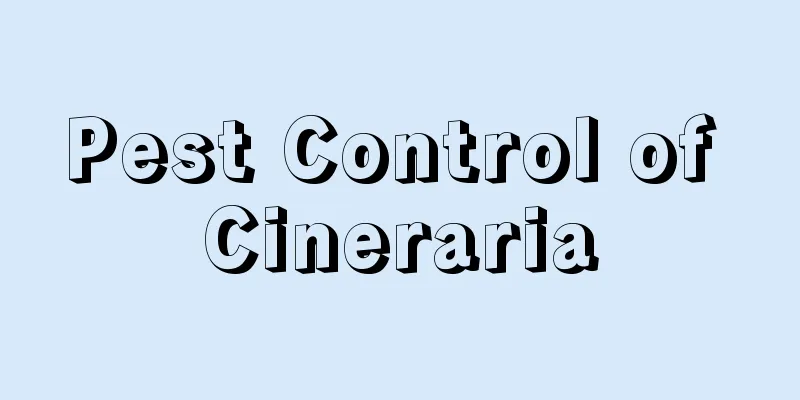Pest Control of Cineraria

Red SpiderharmThe damage caused by red spider mites to cineraria begins in March, when the temperature in the greenhouse is dry. Female adults that have overwintered begin to feed and lay eggs at this time. They usually cause damage around the main veins on the back of the leaves. Small white spots of chlorosis can initially be seen on the front of the affected leaves, which gradually turn red, and a silk screen appears on the back of the leaves. The affected leaves will eventually fall off. Prevention and treatment methods1. The earliest prevention should be in winter. Ensure the environment around the cineraria is clean, remove weeds and fallen leaves in time, check the potting soil, and eliminate the source of overwintering insects. 2. During the period of insect pests, if the cineraria has not yet budded and bloomed, you can spray it with 2000 times 40% trichlorodicofol emulsion or 1000 times 40% omethoate solution once every 7 days, for a total of 2-3 times, for better results. 3. If the cineraria has buds and flowers, try not to spray pesticides to avoid flower sensitivity. In addition to spraying water on the leaves or using chewing gum to remove insects, you can also use the extract of some natural plants such as garlic, onion, and peppercorns, which are mashed and soaked in water for several days, mixed with an appropriate amount of neutral laundry detergent for spraying. aphidharmAphids are small and reproduce quickly. They often gather on the back of leaves and tender stems of Cineraria to suck sap and cause damage. The affected leaves turn yellow and curl and shrink toward the back. Generally, in years with mild winters, early spring warming and even rainfall, damage begins in March. Prevention and treatment methods1. Because aphids overwinter as eggs on cineraria, after checking the plants in winter, spray the plants with 5-degree Baume lime sulfur to eliminate overwintering eggs. 2. During the aphid infestation period, spray 40% omethoate at 1200-2000 times or 40% acephate at 1000 times. To avoid drug damage during the flowering period, you can also use plant-based agents such as 3% natural pyrethrin, 25% dervine essence, and 40% nicotine sulfate, all of which can be diluted to 1000-1500 times. Tussock mothharmThe main damage to cineraria by gypsophila moths is their larvae, which are often called gypsophila caterpillars. Early-stage larvae gather in groups to cause damage, eating the leaf flesh and leaving the epidermis behind, resembling a skylight. Slightly larger poisonous caterpillars cause damage in a scattered manner, biting the leaves into notches and holes. The entire plant is affected starting with the larger lower leaves. The peak period of insect pests is usually in April, when the temperature in the greenhouse is stable at around 20℃. Prevention and treatment methodsIf drug control is adopted, 1000 times diluted 50% cypermethrin or 50% phoxim can be sprayed. However, the cineraria is usually in bloom at this time, so manual capture is the safest option. It is worth noting that caterpillars are poisonous to human skin and can cause dermatitis, so you must wear gloves and use tweezers to catch them to prevent them. |
>>: Pomegranate flower pests and control methods
Recommend
Advantages and disadvantages of Black Magic Rose: Is it suitable for potted plants?
Black Magic is a classic variety of rose. Its flo...
What to do if Ji Qiuli grows too tall
The appearance of elongation After the growth spu...
Why are the peach leaves turning yellow?
Causes and prevention of yellowing of peach leave...
What are the varieties of peony flowers?
Classification According to the layers of petals ...
Cultivation methods and precautions of leopard arrowroot
1. Maintenance methods 1. Temperature: It is afra...
The efficacy and function of Paphiopedilum
The role of Paphiopedilum Watch The biggest funct...
How to grow spring orchids in autumn
1. Breeding conditions 1. Soil: It likes loose, b...
The vine blooms and bears fruit. Plant one in the summer and your small balcony will turn into a fruit orchard!
passion fruit Passion fruit is now sold in superm...
Put some of it in a succulent pot, it will be fat, shiny and shaped like a ball, and the leaves will be thicker than your fingers!
Too meaty and too thin Succulents, of course, loo...
The difference between the use of potassium permanganate and carbendazim
Use of potassium permanganate and carbendazim Whe...
The efficacy and function of fairy fruit
1. Laxative The cactus is rich in cellulose, whic...
Homemade banana nutrient solution, simple and easy to use
Materials needed for homemade banana nutrient sol...
Is it better to grow succulents in a large pot or a small pot? What kind of flower pot is suitable for succulents?
If you want to grow succulents well, it is very i...
How to propagate shrimp flower
Cutting propagation of Shrimp Flower The cuttings...
How to care for and water asparagus fern?
Asparagus fern has become a favorite indoor plant...









